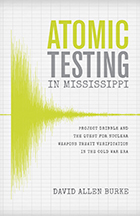
216 pages / 5.50 x 8.50 inches / 15 halftones
History / United States - Southern History | Science / Environmental History | Technology / History of Technology
In Atomic Testing in Mississippi, David Allen Burke illuminates the nearly forgotten history of America’s only nuclear detonations east of the Mississippi River. The atomic tests, conducted in the mid-1960s nearly 3,000 feet below ground in Mississippi’s Tatum Salt Dome, posed a potential risk for those living within 150 miles of the site, which included residents of Hattiesburg, Jackson, Gulfport, Biloxi, Mobile, and New Orleans. While the detonations provided the United States with verification methods that helped limit the world’s nuclear arsenals, they sparked widespread public concern.
“The great strength of the book is the sheer depth and relentlessness of Burke’s research. He has uncovered every document possible about the testing program and has spoken to as many local residents as will talk about the events....He weaves documents, maps, photos, and interviews together into a coherent narrative, and this history is brief, clear, and to the point.”—American Historical Review
“Burke has written an enlightening and provocative book that deserves attention...[A] well-researched and well-written study of a very important topic.”—Journal of Southern History
“This fast-paced history masterfully describes how the Atomic Energy Commission detonated two nuclear devices underground east of the Mississippi River during the mid-1960s. Highly recommended for readers interested in nuclear test bans, nuclear devices, and the impact of nuclear testing on nearby rural communities.”—Charles C. Bates, Chief, Vela Uniform Program, Advanced Research Projects Agency, 1960–1964
"A fascinating account of 'the day we blew up Mississippi’ along with the associated ingredients of local history, state versus federal politics regarding civil rights, and the height of cold war uncertainty.”—Robert A. Frosch, Director of Nuclear Test Detection, Advanced Research Projects Agency, 1963–1965
“A thorough and cogent exploration of a forgotten chapter in American nuclear history. Burke neatly demonstrates that no atomic test takes place in a social or political vacuum, as he traces the implications of the sole American nuclear tests ever performed east of the Mississippi from the Cold War to the politics of the civil rights movement. Burke’s canny juxtaposition of atomic-age urgency with local concerns about cracked chimneys lends real, gripping detail to the kind of story that is usually told only from the perspective of bureaucrats and engineers. Equal parts regional history, environmental history, and history of science, this readable book is an invaluable contribution to all three literatures.”—Matthew B. Lavine, assistant professor of history at Mississippi State University
Found an Error? Tell us about it.